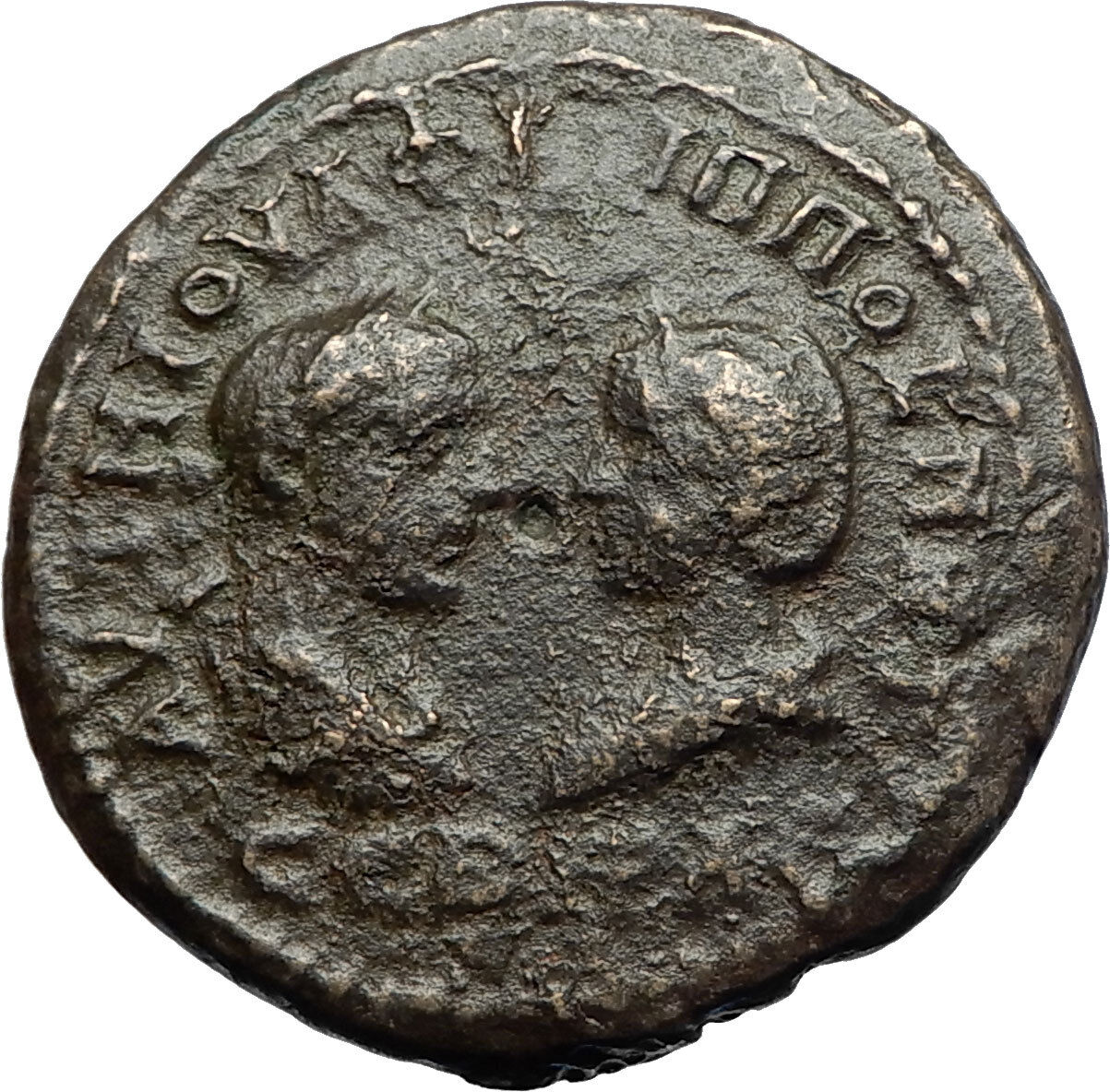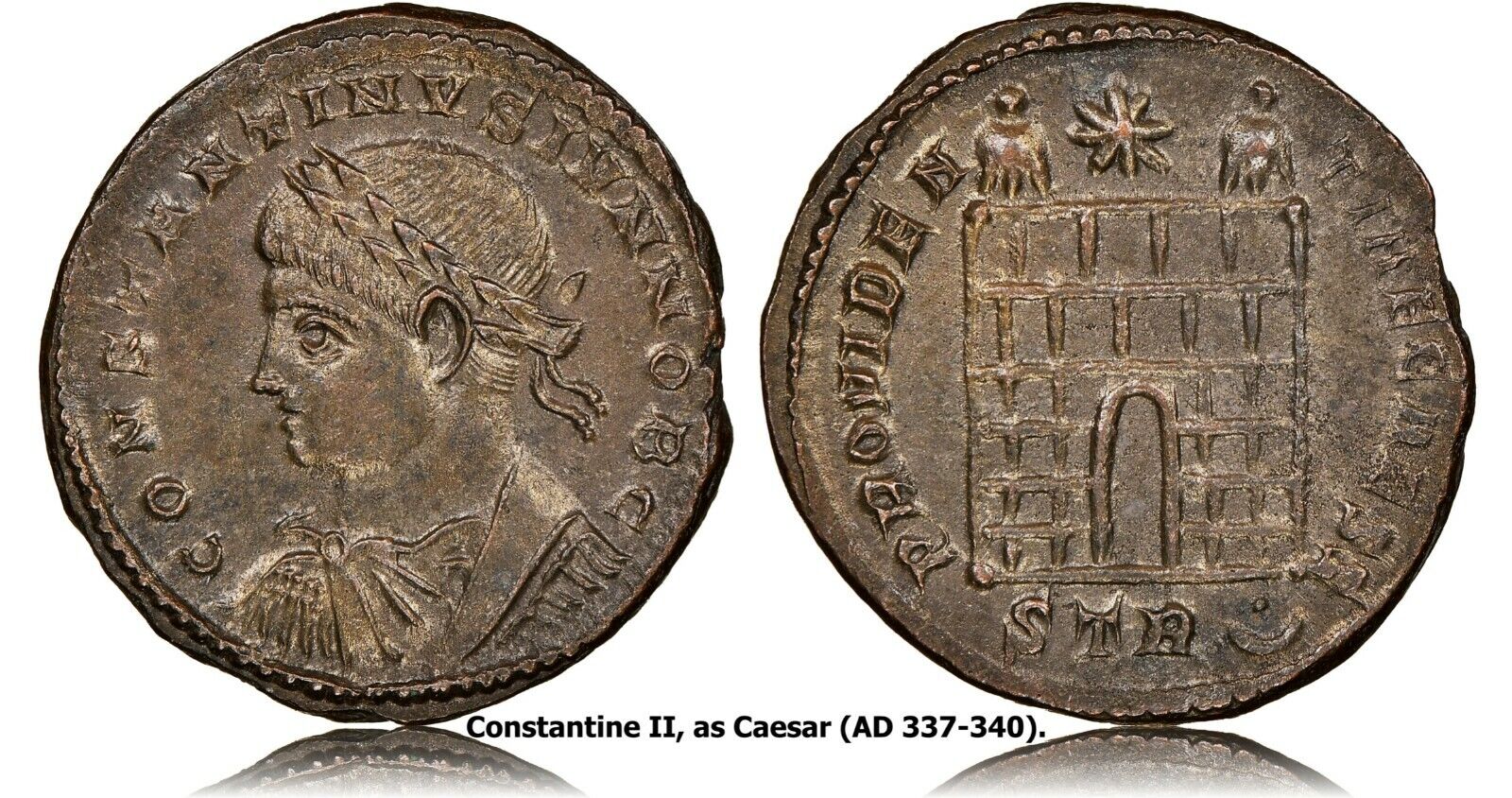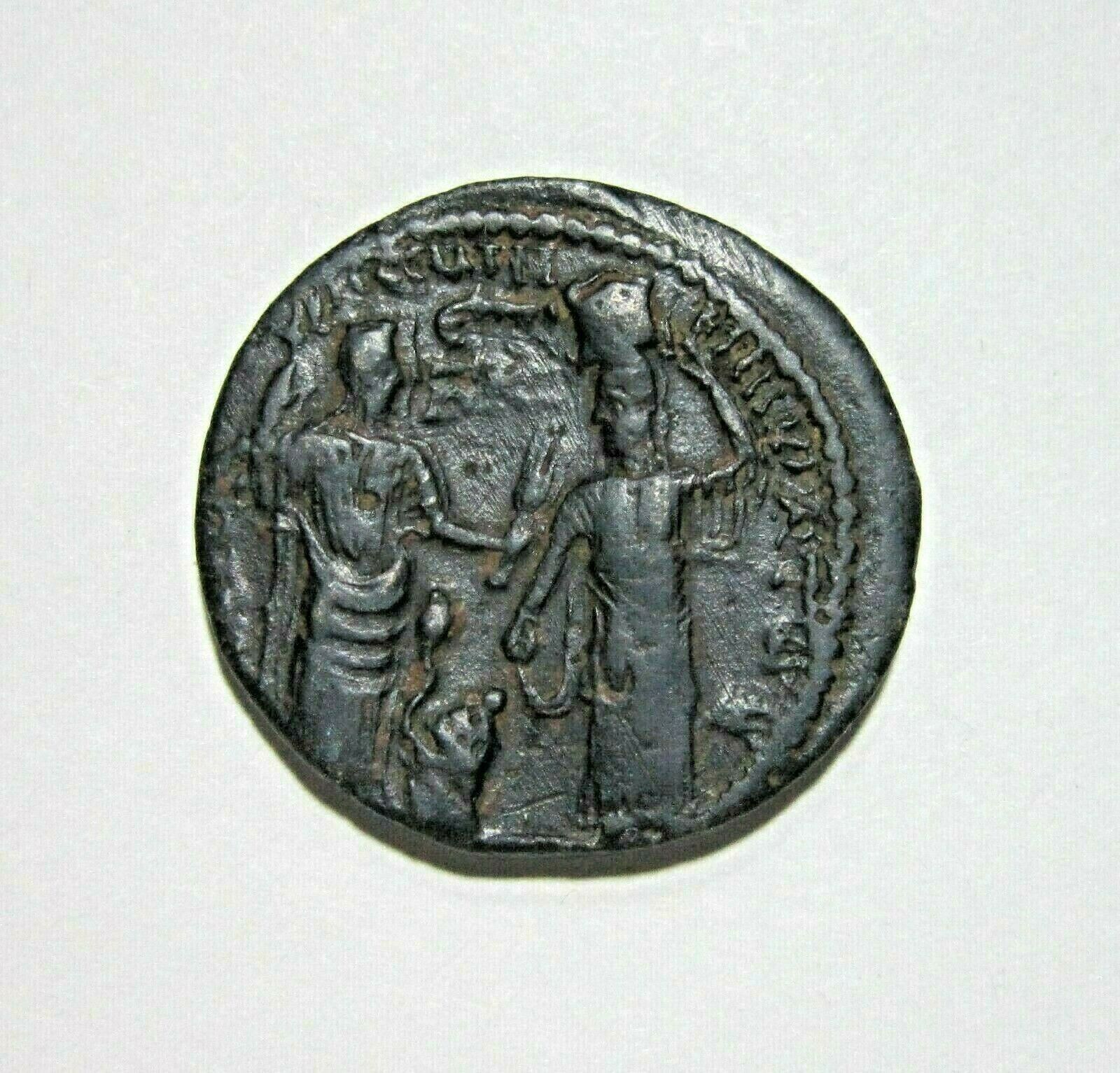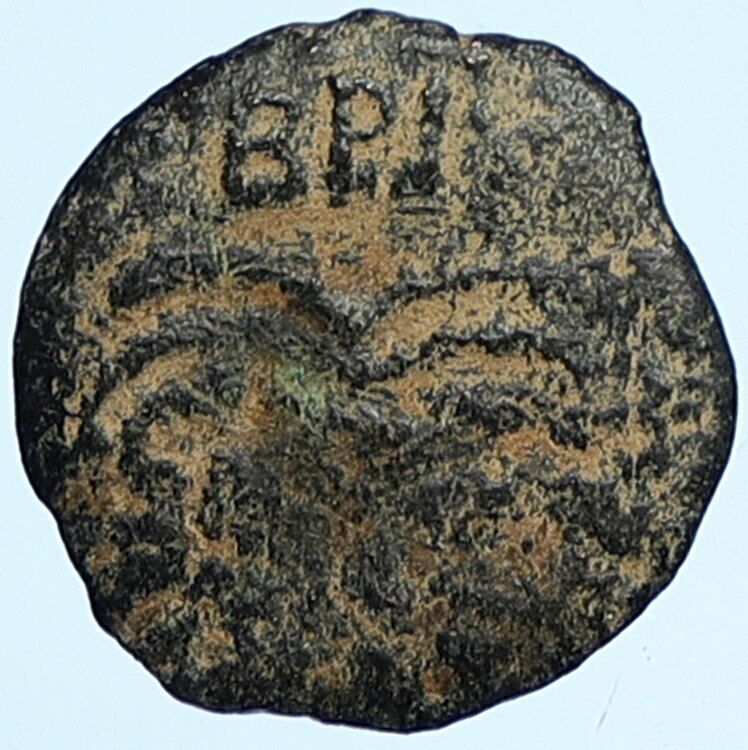-40%
PHILIP I the Arab & Otacilia Severa Mesembria Thrace Roman Coin w HERMES i71062
$ 62.72
- Description
- Size Guide
Description
Item:i71062
Authentic Ancient Coin of:
Philip I 'the Arab'
-
Roman Emperor
: 244-249 A.D.
Bronze 26mm (12.53 grams) of
Mesembria
in
Thrace
Reference: Varbanov 4241
AVT M IOVΛ ΦIΛIΠΠOC M WT CЄBHPAC, Radiate and cuirassed bust left.
MECAMBPIAN
ΩN, Hermes standing facin with his head left, holding money pouch and caduceus.
An important colony of Megara, Mesembria was situated on the Black Sea coast, north of Apollonia Pontika.
You are bidding on the exact item pictured, provided with a Certificate of Authenticity and Lifetime Guarantee of Authenticity.
Hermes
is the great messenger of the gods in Greek mythology and additionally as a guide to the Underworld. Hermes was born on Mount Cyllene in Arcadia. An Olympian god, he is also the patron of boundaries and of the travelers who cross them, of shepherds and cowherds, of the cunning of thieves and liars, of orators and wit, of literature and poets, of athletics and sports, of weights and measures, of invention, and of commerce in general. His symbols include the tortoise, the rooster, the winged sandals, the winged hat, and the caduceus (given to him by Apollo in exchange for the lyre).
Symbols of Hermes were the palm tree, turtle, rooster, goat, the number four, several kinds of fish, incense. Sacrifices involved honey, cakes, pigs, goats, and lambs.
In the Roman adaptation of the Greek religion (see
interpretatio romana
), Hermes was identified with the Roman god Mercury, who, though inherited from the Etruscans, developed many similar characteristics, such as being the patron of commerce.
The Homeric hymn to Hermes invokes him as the one "of many shifts (
polytropos
), blandly cunning, a robber, a cattle driver, a bringer of dreams, a watcher by night, a thief at the gates, one who was soon to show forth wonderful deeds among the deathless gods."
He protects and takes care of all the travelers, miscreants, harlots, old crones and thieves that pray to him or cross his path. He is athletic and is always looking out for runners, or any athletes with injuries who need his help.
Hermes is a messenger from the gods to humans, sharing this role with Iris. An interpreter who bridges the boundaries with strangers is a
hermeneus.
Hermes gives us our word "hermeneutics", the study and theory of interpretation. In Greek a lucky find was a
hermaion
. Hermes delivered messages from Olympus to the mortal world. He wears shoes with wings on them and uses them to fly freely between the mortal and immortal world. Hermes was the second youngest of the Olympian gods, being born before Dionysus.
Hermes, as an inventor of fire, is a parallel of the Titan, Prometheus. In addition to the lyre, Hermes was believed to have invented many types of racing and the sports of wrestling and boxing, and therefore was a patron of athletes.
According to prominent folklorist Yeleazar Meletinsky, Hermes is a deified trickster. Hermes also served as a psychopomp, or an escort for the dead to help them find their way to the afterlife (the Underworld in the Greek myths). In many Greek myths, Hermes was depicted as the only god besides Hades, Persephone, Hecate, and Thanatos who could enter and leave the Underworld without hindrance.
Hermes often helped travelers have a safe and easy journey. Many Greeks would sacrifice to Hermes before any trip.
In the fully-developed Olympian pantheon, Hermes was the son of Zeus and the Pleiade Maia, a daughter of the Titan Atlas. Hermes' symbols were the cock and the tortoise, and he can be recognized by his purse or pouch, winged sandals, winged cap, and the herald's staff, the
kerykeion
. The night he was born he slipped away from Maia and stole his elder brother Apollo's cattle.
Otacilia Severa
-
Roman Empress
: 244-249 A.D.
| Wife of
Philip I 'the Arab'
| Mother of
Philip II
| Daughter in law (possibly posthumously) of
Julius Marinus
|
Marcia Otacilia Severa
or
Otacilia Severa
was the Empress of Rome and wife of Emperor Marcus Julius Philippus or Philip the Arab who reigned over the Roman Empire from 244 to 249.
Severa was a member of the ancient gens Otacilius who were people of consular and senatorial rank. Severa's father was Otacilius Severus or Severianus, who served as Roman Governor of Macedonia and Moesia, while her mother was a member of gens Marcius or was related to the gens. According to sources she had a brother called Severianus, who served as Roman Governor of Lower Moesia between 246-247.
Little is known on her life before marrying Philip. In 234, Severa married Philip who served in the Praetorian Guard under Emperor Alexander Severus. Severa had two children with Philip: a son named Marcus Julius Philippus Severus or Philippus II (born in 238) and - according to numismatic evidence - a daughter called Julia Severa or Severina, who is never mentioned by the ancient Roman sources.
In February 244, Gordian III was killed in Mesopotamia. There is a possibility that Severa was involved in a conspiracy to murder Gordian. Philip became the new emperor who gave his young predecessor a proper funeral and his ashes were returned to Rome for burial.
Philip gave Severa the honorific title of
Augusta
. Their son was made heir of the purple. Sometimes Severa and Philip are considered as the first Christian imperial couple, because during their reign the persecutions of Christians had ceased and the couple had become tolerant towards the faith of the Christians. Through her intervention, she saved Bishop and Saint Babylas of Antioch from persecution.
In August 249, Philip had died in battle in Verona and Decius (emperor) became the new emperor. Severa was in Rome that time. When the news of Philip's death had reached Rome, Severa's son was murdered by the Praetorian Guard. The child died in her arms. Severa survived her husband and son and lived later in obscurity. Her later life is unknown.
Philip I 'the Arab'
-
Emperor
: 244-249 A.D.
Augustus: 244-249 A.D. | 244-247 A.D. (Sole Reign) | 247-249 A.D. (with
Philip II
) |
| Husband of
Otacilia Severa
| Father of
Philip II
| Son of Julius Marinus |
Marcus Julius Philippus
or
Philippus I Arabs
(c. 204-249), known in English as
Philip the Arab
or formerly (prior to World War II) in English as
Philip the Arabian
, was a Roman Emperor from 244 to 249.
Little is known about Philip's early life and political career. He was born in Shahba, about 55 miles southeast of Damascus, in the Roman province of Syria. Philip has the nickname "the Arab" because he had family who had originated in the Arabian peninsula, believed to be distant descendants of the prestigious Baleed family of Aleppo. Philip was the son of a Julius Marinus, a local Roman citizen, possibly of some importance. Many historians agree that he was of Arab descent who gained Roman citizenship through his father, a man of considerable influence. Many citizens from the provinces took Roman names upon acquiring citizenship. This makes tracing his Arabic blood line difficult. However, it is documented that Rome used the Ghassan tribe from the Azd of Yemen as vassals to keep the neighboring northern Arabs in check.
The name of Philip's mother is unknown, but sources refer to a brother, Gaius Julius Priscus, a member of the Praetorian guard under Gordian III (238-244). In 234, Philip married Marcia Otacilia Severa, daughter of a Roman Governor. They had two children: a son named Marcus Julius Philippus Severus (Philippus II) in 238 and according to numismatic evidence they had a daughter called Julia Severa or Severina, whom the ancient Roman sources don't mention.
Philip became a member of the Pretorian Guard during the reign of the emperor Alexander Severus, who was a Syrian. In ancient Rome the Pretorian Guard was closely associated with the emperor, serving among other things as the emperor's bodyguard.
Political career
In 243, during Gordian III's campaign against Shapur I of Persia, the Praetorian prefect Timesitheus died under unclear circumstances. At the suggestion of his brother Priscus, Philip became the new Praetorian prefect, with the intention that the two brothers would control the young Emperor and rule the Roman world as unofficial regents. Following a military defeat, Gordian III died in 244 under circumstances that are still debated. While some claim that Philip conspired in his murder, other accounts (including one coming from the Persian point of view) state that Gordian died in battle. Whatever the case, Philip assumed the purple following Gordian's death. According to Edward Gibbon:
His rise from so obscure a station to the first dignities of the empire seems to prove that he was a bold and able leader. But his boldness prompted him to aspire to the throne, and his abilities were employed to supplant, not to serve, his indulgent master.
Philip was not willing to repeat the mistakes of previous claimants, and was aware that he had to return to Rome in order to secure his position with the senate. He thus travelled west, after concluding a peace treaty with Shapur I, and left his brother Priscus as extraordinary ruler of the Eastern provinces. In Rome he was confirmed
Augustus
, and nominated his young son
Caesar
and heir.
Philip's rule started with yet another Germanic incursion on the provinces of Pannonia and the Goths invaded Moesia (modern-day Serbia and Bulgaria) in the Danube frontier. They were finally defeated in the year 248, but the legions were not satisfied with the result, probably due to a low share of the plunder, if any. Rebellion soon arose and Tiberius Claudius Pacatianus was proclaimed emperor by the troops. The uprising was crushed and Philip nominated Gaius Messius Quintus Decius as governor of the province. Future events would prove this to be a mistake. Pacatianus' revolt was not the only threat to his rule: in the East, Marcus Jotapianus led another uprising in response to the oppressive rule of Priscus and the excessive taxation of the Eastern provinces. Two other usurpers, Marcus Silbannacus and Sponsianus, are reported to have started rebellions without much success.
In April A.D. 248 (April 1000 A.U.C.), Philip had the honour of leading the celebrations of the one thousandth birthday of Rome, which according to tradition was founded in 753 BC by Romulus. He combined the anniversary with the celebration of Rome's alleged tenth saeculum. According to contemporary accounts, the festivities were magnificent and included spectacular games, ludi saeculares, and theatrical presentations throughout the city. In the coliseum, more than 1,000 gladiators were killed along with hundreds of exotic animals including hippos, leopards, lions, giraffes, and one rhinoceros. The events were also celebrated in literature, with several publications, including Asinius Quadratus's
History of a Thousand Years
, specially prepared for the anniversary.
Despite the festive atmosphere, discontent in the legions was growing. Decius (249-251) was proclaimed Emperor by the Danubian armies in the spring of 249 and immediately marched to Rome. Philip's army met the usurper near modern Verona that summer. Decius won the battle and Philip was killed sometime in September 249, either in the fighting or assassinated by his own soldiers who were eager to please the new ruler. Philip's eleven-year-old son and heir may have been killed with his father and Priscus disappeared without a trace.
Religious beliefs
Further information: Philip the Arab and Christianity
Some later traditions, first mentioned in the historian Eusebius in his
Ecclesiastical History
, held that Philip was the first Christian Roman emperor. This tradition seems to be based on reports in Eusebius that Philip allegedly had once entered a Christian service on Easter, after having been required by a bishop to confess his sins. Later versions located this event in Antioch.
However, historians generally identify the later Emperor Constantine, baptised on his deathbed, as the first Christian emperor, and generally describe Philip's adherence to Christianity as dubious, because non-Christian writers do not mention the fact, and because throughout his reign, Philip to all appearances (coinage, etc.) continued to follow the state religion. Critics ascribe Eusebius' claim as probably due to the tolerance Philip showed towards Christians. Saint Quirinus of Rome was, according to a legendary account, the son of Philip the Arab.
Frequently Asked Questions
Mr. Ilya Zlobin
, world-renowned expert numismatist, enthusiast, author and dealer in authentic ancient Greek, ancient Roman, ancient Byzantine, world coins & more.
Who am I dealing with?
You are dealing with Ilya Zlobin, ancient coin expert, enthusiast, author and dealer with an online store having a selection of over 15,000 items with great positive feedback from verified buyers and over 10 years experience dealing with over 57,000 ancient and world coins and artifacts. Ilya Zlobin is an independent individual who has a passion for coin collecting, research and understanding the importance of the historical context and significance all coins and objects represent. Most others are only concerned with selling you, Ilya Zlobin is most interested in educating you on the subject, and providing the largest selection, most professional presentation and service for the best long-term value for collectors worldwide creating returning patrons sharing in the passion of ancient and world coin collecting for a lifetime.
How long until my order is shipped?
Orders are shipped by the next business day (after receipt of payment) most of the time.
How will I know when the order was shipped?
After your order has shipped, you will be left positive feedback, and that date could be used as a basis of estimating an arrival date. Any tracking number would be found under your 'Purchase history' tab.
USPS First Class mail takes about 3-5 business days to arrive in the U.S. International shipping times cannot be estimated as they vary from country to country.
Standard international mail to many countries
does not
include a tracking number, and can also be slow sometimes.
For a tracking number and signature confirmation, you may want to do Express Mail International Shipping, which costs more, however, is the fastest and most secure. Additionally you may be able to receive your order in as little as 3-5 business days using this method. For Express Mail International, it may be possible to place up to 10-15 items in one package (for the one shipping cost) as it is flat rate envelope, which may be the most cost-effective, secure and fastest way to receive items internationally. Send me a message about this and I can update your invoice should you want this method.
Getting your order to you, quickly and securely is a top priority and is taken seriously here.
Great care is taken in packaging and mailing every item securely and quickly.
Please be aware, I cannot take responsibility for any postal service delivery delays, especially for international packages as it may happen in rare instances.
What is a certificate of authenticity and what guarantees do you give that the item is authentic?
Each of the items sold here, is provided with a Certificate of Authenticity, and a Lifetime Guarantee of Authenticity, issued by a world-renowned numismatic and antique expert that has identified over 57,000 ancient coins and has provided them with the same guarantee. You will be very happy with what you get with the COA; a professional presentation of the coin, with all of the relevant information and a picture of the coin you saw in the listing. Additionally, the coin is inside it's own protective coin flip (holder), with a 2x2 inch description of the coin matching the individual number on the COA.
On the free-market such a presentation alone, can be considered a - value all in itself, and it comes standard with your purchases from me,
FREE.
With every purchase, you are leveraging my many years of experience to get a more complete context and understanding of the piece of history you are getting. Whether your goal is to collect or give the item as a gift, coins presented like this could be more prized and valued higher than items that were not given such care and attention to.
Buy a coin today and own a piece of history, guaranteed.
Is there a money back guarantee?
I offer a 30 day unconditional money back guarantee. I stand behind my coins and would be willing to exchange your order for either store credit towards other coins, or refund, minus shipping expenses, within 30 days from the receipt of your order. My goal is to have the returning customers for a lifetime, and I am so sure in my coins, their authenticity, numismatic value and beauty, I can offer such a guarantee.
When should I leave feedback?
Once you receive your order, please leave a positive feedback. Please don't leave any negative feedbacks, as it happens sometimes that people rush to leave feedback before letting sufficient time for their order to arrive. Also, if you sent an email, make sure to check for my reply in your messages before claiming that you didn't receive a response. The matter of fact is that any issues can be resolved, as reputation is most important to me. My goal is to provide superior products and quality of service.
How and where do I learn more about collecting ancient coins?
Visit the
"Guide on How to Use My Store"
for on an overview about using my store, with additional information and links to all other parts of my store which may include educational information on topics you are looking for.











